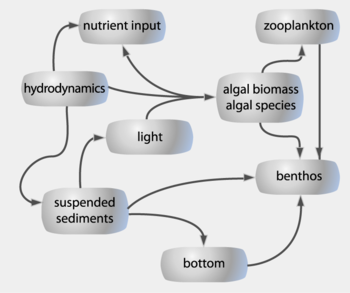Coupled hydrodynamic - water quality - ecological modelling
Numerical models are increasingly being used together with field monitoring data as research and management tools to help understand the behaviour and functioning of a specific natural system. A common type of model used in coastal waters is a coupled coupled hydrodynamic - water quality - ecological model. Such models can be used to study historic conditions in a specific region to try to fully understand the changes that have occured (trends) and the main human factors and natural processes that can explain such changes. If a numerical model is well calibrated and validated for a specific region using historical data, it can also be used to predict future conditions. As such, computational models used for real-time and forecasting calculations can be an important component of a coastal observatory. This article on Coupled hydrodynamic - water quality - ecological modelling presents the 'effect chain' approach for modelling marine and coastal water quality and ecology.
Contents
Introduction
This article describes an integrated modelling approach in which hydrodynamics, suspended sediment dynamics (water quality) are combined in order to simulate algae primary production and nutrient concentrations. Such an integrated modelling approach generally requires a series of coupled models, or an 'effect chain' as shown in Figure 1. The hydrodynamic model is the starting point of this effect chain, as it determines the water circulation, which in turn influences the transport and distribution of suspended sediments and nutrients. The suspended sediments influence the intensity of light in the water, which together with the available nutrient concentrations determines the algal biomass and net primary production due to algae growth and mortality. When algae die, the nutrients in their cells are partly released back into the water, creating a nutrient cycle. Some dead algae cells settle to the bottom as organic detritus and become part of the benthic system (benthos). Algae biomass can be consumed (grazed) by zooplankton, which are the next species higher up in the food chain. The effect chain shown in Figure 1 could be extended to include a more complete food chain model, including pelagic fish, demersal fish, birds and marine mammals.Hydrodynamic models
Hydrodynamic models, generally 2D or 3D, calculate the circulation of coastal water based on tides and wind, and the discharge from coastal rivers. More specifically, the models calculate water velocities (speed and direction) and water levels for each grid cell in the computational model grid. An example of a model grid for the North Sea, including the bathymetry (depth)is shown in Figure 2. This same grid is used for the hydrodynamic, water quality and ecological models. The hydrodynamic models generally also calculate salinity as well as water temperature, based on heat balance equations. These last two parameters are especially relevant for 3D hydrodynamic calculations where density differences due to temperature and salinity can play an important role in the circulation of water.
The hydrodynamic model results of water level, velocities, temperature and salinity are passed on to the sediment or water quality model where they are used for calculationg the advective transport of dissolved and suspended material in the water. The temperature and salinity values are important in the calculation of many chemical and biological processes, as the rates for many of these processes are temperature and salinity dependent.
Water quality models
The term 'water quality model' is very general and can imply many different kinds of models. However, the main component of water quality models in coupled hydrodynamic-water quality-ecological modelling systems is the calculation of suspended sediment concencentrations. These concentrations, which can be variable in time and space, are important for determining the availability of light in the water column, also known as the underwater light field. The underwater light field is one of the main parameters governing the primary production of phytoplankton. The underwater light field is a function of the solar irradiation on the water surface of light within a certain wave length range and of the attenuation or extinction by absorption and scattering of the light inside the water column. The extinction of light is strongly determined by the water quality: the presence of certain constituents enhances the light attenuation characteristics of the water.
Several methods are possible for suspended sediment modelling. A deterministic modelling approach takes into account all the sources of sediment into a water system (e.g. from rivers) and considers the transport, sedimentation and resuspension (erosion)of this sediment as a function of the water flow, waves and wind. This modelling approach uses the results from the hydrodynamic model in the calculations.
Another simplified approach is to use a pre-defined function for suspended sediment concentration, possibly varying with the location, time of year and/or wind velocity. More advanced approaches incorporate optical remote sensing data (e.g. from SeaWiFS or MERIS) which can provide measured suspended sediment concentrations in the surface water layer.
Ecological models
In coupled hydrodynamic-water quality-ecological modelling systems, the ecological model component is generally focused on the modelling of primary production and mortality, as well as concentrations of chlorophyll, nutrients and oxygen. These parameters are all linked to one another by a complex set of inter-related processes. Algae primary production (growth) is a function of the available nutrients (nitrogen, phosphorus and silica) as well as light. A major source of nutrients is river discharges, which generally carry elevated nutrient concentrations relative to sea water. Additional sources of nutrients can be direct discharges from water water treatment plants. An important component in the ecological modelling is identifying and quantifying all the sources of nutrients. The available light is primarily a function of the (inorganic and organic) suspended sediment concentrations, which are calculated in the water quality model.
See also
For information on the use of models, see also:
- How to apply models
- Reduction of uncertainties through Data Model Integration (DMI)
- Modelling coastal hydrodynamics
References
References are missing
Please note that others may also have edited the contents of this article.
|

